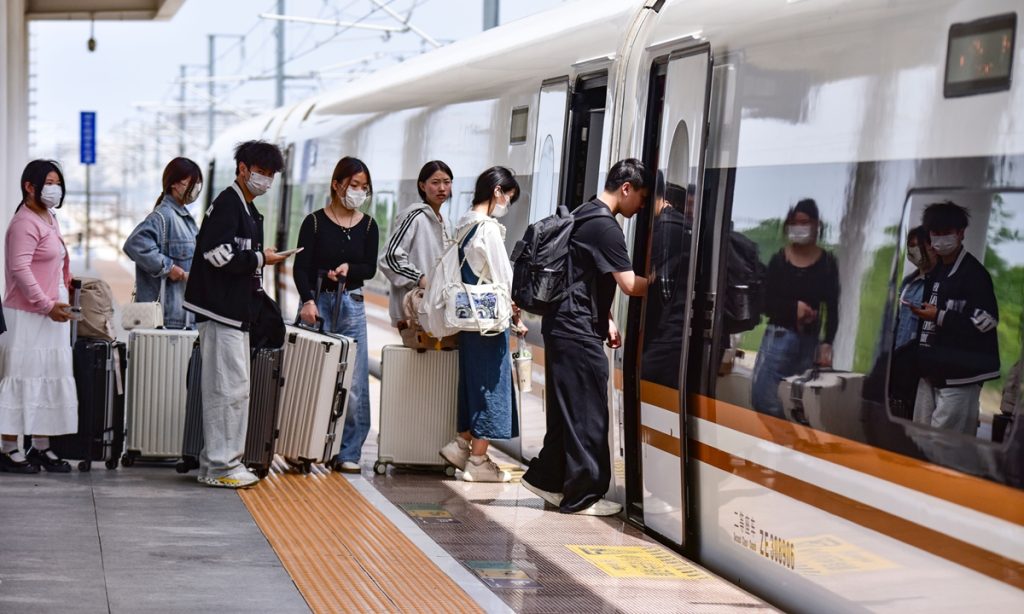China's railways to handle 144 million passenger trips during May Day travel rush

China's railway travel rush period for the upcoming May Day holidays officially began on Tuesday, with some routes already experiencing the first wave of passenger surges. The surge comes as travel platforms predict "the busiest May Day holiday in three years," driven by growing consumption potential amid the country's continued focus on its own affairs despite global economic headwinds triggered by US tariff hikes.
This year's May Day travel period runs from April 29 to May 6, spanning a total of eight days. Nationwide, China's railways are expected to handle 144 million passenger trips, up 4.9 percent year-on-year. Passenger traffic is expected to reach its peak on Thursday, the first day of the five-day May Day holidays, according to a statement China Railway sent to the Global Times on Tuesday.
The China Railway Guangzhou Group reported the first wave of peak travel on Tuesday, expecting to handle 1.856 million passenger trips - an increase of 350,000 from the previous day, the Global Times learned from the company.
Data from travel platform LY.com showed that travel demand for the upcoming holidays is expected to reach its highest level in nearly three years. Beijing, Chengdu and Shanghai rank as the top three domestic travel destinations, with Chengdu maintaining strong popularity - boosted further by the runaway success of the film Nezha 2, the platform revealed.
As travel spending power continues to rise, high-end domestic hotels have seen significantly stronger booking demand compared to three-star and lower-rated accommodations, LY.com said.
China's civil aviation sector is also gearing up to accommodate the surge in holiday travel demand. The sector is expected to handle approximately 10.75 million passenger trips, averaging 2.15 million daily. This represents an 8 percent year-on-year increase compared to 2024, setting a new record for the same period, the Civil Aviation Administration of China (CAAC) said on Sunday.
Popular travel destinations for Chinese tourists are mainly concentrated in traditional tourism markets such as Japan, South Korea and Southeast Asia, according to CAAC.
The Beijing Daxing International Airport said on Tuesday that it is expected to handle 4,687 flights during the holiday period, up 5.7 percent from the same period last year, and make around 714,000 passenger trips, an 8.1 percent increase year-on-year - both figures likely to mark new highs since the airport began operations in 2019.
As income levels rise, Chinese consumers are moving beyond material consumption, with spending patterns shifting toward travel, wellness and cultural experiences rather than just basic needs, Cao Heping, an economist at Peking University, told the Global Times on Tuesday.
Continued investment in high-speed rail, expressways and other infrastructure has strengthened China's tourism foundation and created a favorable environment for consumption upgrades. The central government has repeatedly signaled its commitment to expanding domestic demand, with supportive policies further fueling the tourism boom, Cao noted.
In a fresh move to boost inbound spending, China unveiled a new set of measures on Sunday to further optimize its departure tax refund policy to improve overseas travelers' shopping experience, according to the Xinhua News Agency.
The minimum purchase threshold for departure tax refunds has been lowered, allowing overseas travelers to apply for a refund if they spend at least 200 yuan ($27.75) at the same store on the same day and meet other relevant requirements.
In the first quarter of this year, China recorded 9.215 million inbound tourist visits, up 40.2 percent year-on-year. In 2024, the country welcomed 26.94 million foreign visitors - a 96 percent increase from the previous year - with total inbound tourism spending reaching $94.2 billion, up 77.8 percent, Xinhua said in a separate report.
From the viral success of American YouTuber IShowSpeed's China travel series to the booming overseas sales of Chinese products on platforms like Taobao and DHgate, the trend reflects growing recognition of Chinese products, experiences and development among foreign visitors - as well as a broader appreciation for traditional Chinese culture and the Chinese way of life, Sun Jiashan, an associate researcher at the Central Academy of Culture and Tourism Administration, told the Global Times on Tuesday.
Tourism is not only a result of rising consumption, but also a powerful driver of consumption upgrading. As people travel, they generate spending across accommodation, dining, transportation, entertainment, and shopping - fueling the growth of related industries along the value chain, Cao stressed.
Against the backdrop of Washington's tariff policies causing turbulence across the global markets, it is essential for China to stay focused on its own development priorities, accelerating domestic demand and advancing high-quality growth, Cao said, adding that domestic demand is expected to become a bright spot in China's economic performance, with the country aiming to further strengthen the role of consumption in driving growth and to leverage its vast domestic market to better withstand external risks and challenges.